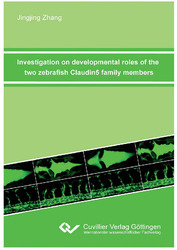| Departments | |
|---|---|
| Book Series (96) |
1378
|
| Nachhaltigkeit |
3
|
| Gesundheitswesen |
1
|
| Humanities |
2364
|
| Natural Sciences |
5406
|
| Mathematics | 229 |
| Informatics | 319 |
| Physics | 980 |
| Chemistry | 1363 |
| Geosciences | 131 |
| Human medicine | 243 |
| Stomatology | 10 |
| Veterinary medicine | 108 |
| Pharmacy | 147 |
| Biology | 835 |
| Biochemistry, molecular biology, gene technology | 121 |
| Biophysics | 25 |
| Domestic and nutritional science | 45 |
| Agricultural science | 1004 |
| Forest science | 201 |
| Horticultural science | 20 |
| Environmental research, ecology and landscape conservation | 148 |
| Engineering |
1793
|
| Common |
98
|
|
Leitlinien Unfallchirurgie
5. Auflage bestellen |
|
Advanced Search
Investigation on developmental roles of the two zebrafish Claudin5 family members (English shop)
Jingjing Zhang (Author)Preview
Table of Contents, Datei (55 KB)
Extract, Datei (68 KB)
Tight junctions (TJs) are main structural elements of epithelial/endothelial cell layer barrier
systems. Members of the Claudin (Cldn) family are transmembrane proteins that determine
paracellular permeability properties. Much of what we have learned about barrier- and poreforming
roles of Cldns stems from work in different cell lines. However, recent studies have
provided evidence for roles of Cldns in development and disease. These latter functions cannot be
adequately studied in tissue culture systems, which highlights the need to manipulate these
proteins and to elucidate their functions within complex model organisms.
In this study, the developmental functions of Cldn5a and Cldn5b were characterized during
zebrafish (Danio rerio) embryonic morphogenesis. Expression analysis of both Cldn5 isoforms
during zebrafish development revealed that Cldn5a is expressed within the embryonic
neuroepithelium and within arterial endothelial cells, whereas Cldn5b is primarily expressed
within arteries. Cldn5a is essential for the formation of an embryonic neuroepithelial-ventricular
barrier which is required for brain ventricular expansion. Genetic analyses showed that Cldn5a
functions downstream of tissue polarity cues which are essential for the establishment of the
neuroepithelial-ventricular barrier. This barrier, together with the Na+,K+-ATPase ionic pump
function, which generates the hydrostatic pressure within the ventricular lumen, contributes to
embryonic brain ventricular expansion.
The study also revealed that during zebrafish vasculogenesis, Cldn5a and Cldnb are essential
for the separation of arteries and veins. Loss of both Cldn5 proteins prevents the separation of
arterial and venous cells without affecting their differentiation. Functional rescue experiments
with a TJ pore-opening Cldn5a mutant complemented the loss of Cldn5 during vasculogenesis.
This indicates a role of Cldn5s that is separate from TJ belt formation and sealing function, such
as affecting cell motility or cell-cell adhesion behavior.
| ISBN-13 (Printausgabe) | 3869555467 |
| ISBN-13 (Hard Copy) | 9783869555461 |
| Language | English |
| Page Number | 108 |
| Edition | 1 Aufl. |
| Volume | 0 |
| Publication Place | Göttingen |
| Place of Dissertation | Universität Berlin |
| Publication Date | 2010-11-11 |
| General Categorization | Dissertation |
| Departments |
Biology
|








